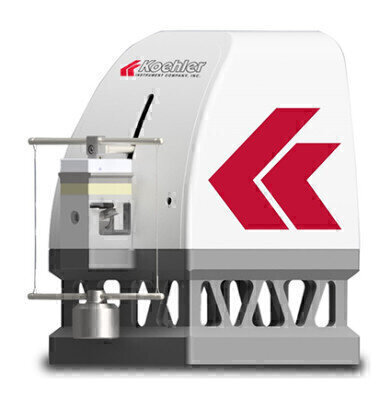Analytical Instrumentation
New high frequency reciprocating rig
Jan 17 2020
Koehler Instrument Company, Inc recently introduced their newly redesigned High Frequency Reciprocating Rig. This instrument can be used for the evaluation of the lubricity of diesel fuels utilising a high frequency reciprocating rig (HFRR). A 2-mL test specimen of fuel is placed in the test reservoir and maintained at 25 or 60°C. At the point of temperature stabilisation, a vibrating arm, wielding a non-rotating steel ball and loaded with a 200-g mass, subsequently descends until it makes contact with a test disk entirely submerged in the fuel. A 1-mm stroke, at a frequency of 50 Hz for 75 minutes, is the catalyst which causes the ball to rub against the disk. The ball is then removed from the vibrating arm and cleansed. The dimensions of the major and minor axes of the wear scar are measured under magnification and recorded.
The specifications include the following: it conforms to ASTM D6079, D7688; ISO 12156; IP 450; EN 590; CEC F-06-S. The HFRR has a variable frequency ranging from 10 Hz to 200 Hz via software (K9346X Model). Wear scar measurement occurs through a digital microscope and software. The instrument features real time data acquisition of frictional force, temperature and humidity (K9346X Model). Programmed test sequences to facilitate automated examination are included. PC-based digital and data acquisition is featured as well (K9346X Model). In addition, the user can rely on proven repeatability and reproducibility of empirical data from the sturdily built and dependable table top rig.
The versatility of the high frequency reciprocating rig is found in a computerized piece of equipment adept at accurate detection of frictional behavior and the wear properties of materials under both dry and lubricated conditions. Reciprocation motion takes place employing the fixed stationary counter surface materials, mounted on a small lubricant bath, and the reciprocating specimen (ball) frequency, displacement and normal load, chosen based on individual test requirements.
Digital Edition
PIN 25.1 Feb/March
March 2024
In This Edition Safety - The technology behind the ION Science Tiger XT - Safety with ammonia and LOHCs as hydrogen carriers Analytical Instrumentation - Discussion on new tribology te...
View all digital editions
Events
Apr 28 2024 Montreal, Quebec, Canada
Apr 30 2024 Birmingham, UK
May 03 2024 Seoul, South Korea
May 05 2024 Seville, Spain
May 06 2024 Riyadh, Saudi Arabia


















